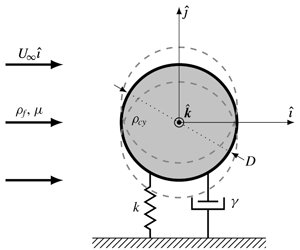Article contents
Vortex-induced vibration prediction via an impedance criterion
Published online by Cambridge University Press: 04 March 2020
Abstract

The vortex-induced vibration of a spring-mounted, damped, rigid circular cylinder, immersed in a Newtonian viscous flow and capable of moving in the direction orthogonal to the unperturbed flow is investigated for Reynolds numbers  $Re$ in the vicinity of the onset of unsteadiness (
$Re$ in the vicinity of the onset of unsteadiness ( $15\leqslant Re\leqslant 60$) using the incompressible linearised Navier–Stokes equations. In a first step, we solve the linear problem considering an imposed harmonic motion of the cylinder. Results are interpreted in terms of the mechanical impedance, i.e. the ratio between the vertical force coefficient and the cylinder velocity, which is represented as function of the Reynolds number and the driving frequency. Considering the energy transfer between the cylinder and the fluid, we show that impedance results provide a simple criterion allowing the prediction of the onset of instability of the coupled fluid-elastic structure case. A global stability analysis of the fully coupled fluid/cylinder system is then performed. The instability thresholds obtained by this second approach are found to be in perfect agreement with the predictions of the impedance-based criterion. A theoretical argument, based on asymptotic developments, is then provided to give a prediction of eigenvalues of the coupled problem, as well as to characterise the region of instability beyond the threshold as function of the reduced velocity
$15\leqslant Re\leqslant 60$) using the incompressible linearised Navier–Stokes equations. In a first step, we solve the linear problem considering an imposed harmonic motion of the cylinder. Results are interpreted in terms of the mechanical impedance, i.e. the ratio between the vertical force coefficient and the cylinder velocity, which is represented as function of the Reynolds number and the driving frequency. Considering the energy transfer between the cylinder and the fluid, we show that impedance results provide a simple criterion allowing the prediction of the onset of instability of the coupled fluid-elastic structure case. A global stability analysis of the fully coupled fluid/cylinder system is then performed. The instability thresholds obtained by this second approach are found to be in perfect agreement with the predictions of the impedance-based criterion. A theoretical argument, based on asymptotic developments, is then provided to give a prediction of eigenvalues of the coupled problem, as well as to characterise the region of instability beyond the threshold as function of the reduced velocity  $U^{\ast }$, the dimensionless mass
$U^{\ast }$, the dimensionless mass  $m^{\ast }$ and the Reynolds number. The influence of the damping parameter
$m^{\ast }$ and the Reynolds number. The influence of the damping parameter  $\unicode[STIX]{x1D6FE}$ on the instability region is also explored.
$\unicode[STIX]{x1D6FE}$ on the instability region is also explored.
JFM classification
- Type
- JFM Papers
- Information
- Copyright
- © The Author(s), 2020. Published by Cambridge University Press
References
- 8
- Cited by




